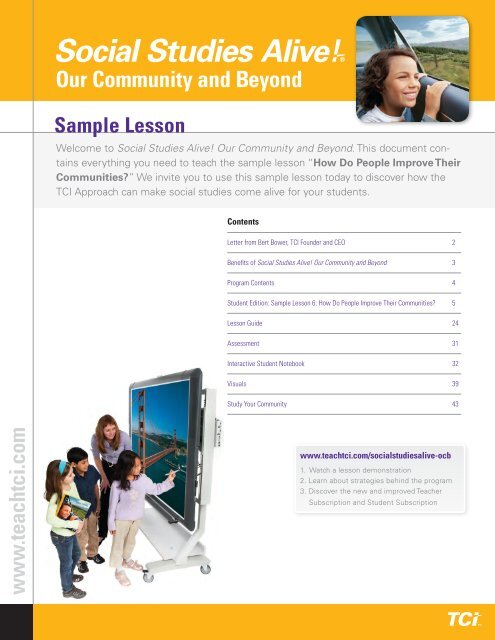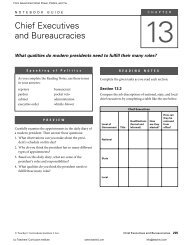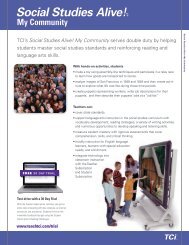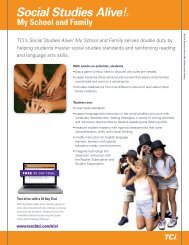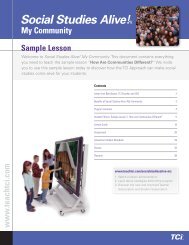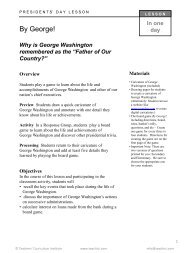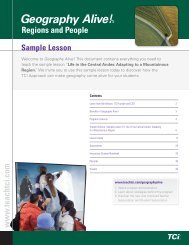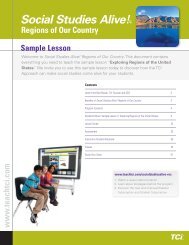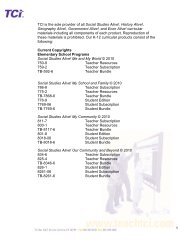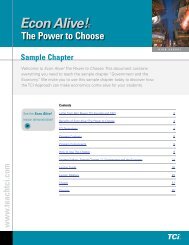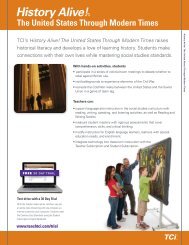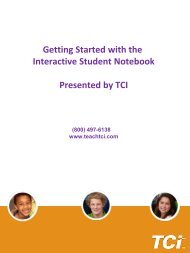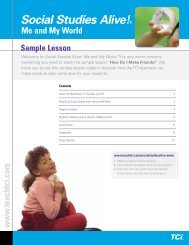Social Studies Alive! Our Community and Beyond | Sample ... - TCI
Social Studies Alive! Our Community and Beyond | Sample ... - TCI
Social Studies Alive! Our Community and Beyond | Sample ... - TCI
- No tags were found...
Create successful ePaper yourself
Turn your PDF publications into a flip-book with our unique Google optimized e-Paper software.
How Do PeopleImprove TheirCommunities?6<strong>Our</strong> communities bring us manygood things. They are full of diversepeople <strong>and</strong> interesting places. Butcommunities can have problems,too. When people see theseproblems, they can help solvethem. Just one person can makea big difference.In this chapter, you’ll read aboutfour people who set out to solveproblems in their own communities.They each made their town or city abetter place to live. Their work alsohelped people in many other places.| Student Edition | Lesson Guide | Lesson Masters | Interactive Student Notebook | Visuals | Study Your <strong>Community</strong>7
César Chávez (inthe middle) madelife better forfarmworkers.6.1 César Chávez Helps FarmworkersCésar (SAY-zahr) Chávez came from a poor family.When he was still a teenager, he became a migrantfarmworker to help his family.Farmworkers had hard lives. They worked longhours for very little pay. Often workers got sick orhurt because they had to use unsafe chemicals<strong>and</strong> machines.As a young man, César wanted to help thefarmworkers. In 1962, he helped to start a new group.It became known as theUnited Farm Workers ofAmerica, or UFW. TheUFW helped the workersask for better pay <strong>and</strong> saferworking conditions.At that time, César livedin the town of Delano,California. There were farmsall around the town. Atfirst, the farm owners thererefused to listen to the UFW.So César told all the workersto stop picking the crops.Stopping work in this way iscalled a strike. César hopedthe strike would make theowners pay more attentionto the workers.| Student Edition | Lesson Guide | Lesson Masters | Interactive Student Notebook | Visuals | Study Your <strong>Community</strong>876
| Student Edition | Lesson Guide | Lesson Masters | Interactive Student Notebook | Visuals | Study Your <strong>Community</strong>9The owners still didn’t listen. César took anotherstep. He asked people to stop buying what the farmssold. This is called a boycott.It took five years, but many of the farm ownersfinally gave in. They agreed to pay the farmworkersmore. The owners also promised that they wouldmake the work safer.César Chávez helped to make Delano a better placefor farmworkers. He went on to help farmworkers inmany other places around the country. César helpedthem get better pay <strong>and</strong> safer ways of working.These people aremarching to showtheir support for theUFW.77
Ruby Bridgesmade history whenshe was just sixyears old.786.2 Ruby Bridges Helps African AmericansIn 1960, Ruby Bridges was six years old. She wasready to start first grade. When she did, she wouldmake history.Ruby lived in New Orleans, Louisiana. At that time,black students <strong>and</strong> white students in New Orleanswent to different schools. Ruby would be the firstAfrican American to goto the white school nearher home.Many white people wereupset. They wanted black<strong>and</strong> white students to bekept apart. Still, Ruby’smother was hopeful. Shethought the school was agood one. And she thoughtit was time that black <strong>and</strong>white children went to thesame schools. But Ruby’sfather was worried. “We’rejust asking for trouble,”he said.Ruby’s first day of schoolwas frightening. Outsidethe school, crowds of angrypeople threw things at her.They yelled, “Blacks don’tbelong in our schools!” Rubythought some of them mighteven hurt her.| Student Edition | Lesson Guide | Lesson Masters | Interactive Student Notebook | Visuals | Study Your <strong>Community</strong>10
Inside the school, Ruby discovered she was theonly student in her classroom. All the others hadstayed home.For months, Ruby was the only student in herclass. Still, she kept coming to school. People startedto see that she wasn’t going away. One day, two whitechildren came to school with her. Then more <strong>and</strong>more students came back to school.Ruby made it easier for all children in New Orleansto go to good schools together. As an adult, Rubyhelps people in other communities, too. She talks tochildren <strong>and</strong> adults about her experience <strong>and</strong> how wecan still learn from it today.Ruby helped toshow people thatblack <strong>and</strong> whitechildren could go tothe same schools.| Student Edition | Lesson Guide | Lesson Masters | Interactive Student Notebook | Visuals | Study Your <strong>Community</strong>1179
Lois Gibbs wantedto know whychildren near LoveCanal were gettingsick.6.3 Lois Marie Gibbs Helps Make Her<strong>Community</strong> SaferIn 1978, Lois Marie Gibbs lived in Niagara Falls, NewYork. Lois had two children, Michael <strong>and</strong> Melissa.Michael became very sick. Lois wanted to know why.There was an old canal,or waterway, near Michael’sschool. It was called LoveCanal. Businesses had beendumping dangerous chemicalsinto the canal for years.Love Canal flowedunderneath the schoolplayground. Lois thought thedirty canal was making herchildren sick.Lois didn’t know what to do.No one believed her fears aboutLove Canal.Lois asked her neighborsabout their health. It turned outthat many of the children in thearea were sick. Some scientistsagreed that the canal could bethe problem.Lois decided to do somethingabout it. She got all her neighbors together. Lois <strong>and</strong>her neighbors knew they needed help. They decided totell everyone they could about their problem.| Student Edition | Lesson Guide | Lesson Masters | Interactive Student Notebook | Visuals | Study Your <strong>Community</strong>1280
81| Student Edition | Lesson Guide | Lesson Masters | Interactive Student Notebook | Visuals | Study Your <strong>Community</strong>13Lois <strong>and</strong> her neighbors made signs to carry. Thenthey followed the governor of New York around.People saw them on television.Finally, the governor came to visit Love Canal. Heagreed to help families move to a safer place. Later,President Jimmy Carter helped, too.Lois Gibbs made a big difference in her community.Later, she helped people in other towns <strong>and</strong> cities.She showed them how to join together to make theircommunities safer places to live.This school wasclosed because ofthe chemicals inLove Canal.
Judy Heumannstarted the groupDisabled in Action.6.4 Judy Heumann Helps Disabled PeopleJudy Heumann (HEW-man) was born in 1947. Whenshe was a baby, she got sick with polio. This diseasehurt her legs. Judy would never be able to walk. Shehad to use a wheelchair to get around.Judy lived in Brooklyn, New York. On herfirst day of first grade, her mother broughther to school. The principal wouldn’t letJudy in because she was in a wheelchair. Ateacher came to Judy’s house for a few hourseach week instead.When Judy was in fourth grade, she wasfinally allowed to go to school. There shemet other disabled students. Disabledmeans not being able to do an everydaything, like walk, talk, hear, or learn, inthe same way that most people can. Judylearned that the other disabled students feltthe same way she did. Her legs didn’t workright, but she wanted to learn as much asany other student.In college, Judy studied to be a teacher. At first,New York City wouldn’t let her teach because she wasin a wheelchair. Judy went to court to win the right toteach. She taught school for three years.In 1970, Judy formed a group called Disabled inAction. She started the group to protect disabledpeople in New York from being treated unfairly.The group has grown a lot since then. Today it helpsdisabled people all across the country live better lives.| Student Edition | Lesson Guide | Assessment | Interactive Student Notebook | Visuals | Study Your <strong>Community</strong>1482
83Thanks to Judy,disabled studentslike these aretreated more fairly.| Student Edition | Lesson Guide | Assessment | Interactive Student Notebook | Visuals | Study Your <strong>Community</strong>15SummaryIn this chapter, you met four special people. César Chávez,Ruby Bridges, Lois Marie Gibbs, <strong>and</strong> Judy Heumann allhelped to improve their communities. They made otherpeople’s lives better. Their work helped people in many otherplaces, too. What can you do to make your community abetter place?
ReadingFurther6People beingrescued fromthe flood in NewOrleansHelping a <strong>Community</strong> in NeedSometimes problems are too big for a townor a city to solve by itself. In 2005, a flood putmost of New Orleans under water. Homes<strong>and</strong> businesses were ruined. Thous<strong>and</strong>s ofpeople had no food or shelter. Who reachedout to help?The city of New Orleans sits on very lowground. Nearby there is a large lake.Years ago, levees, or walls, were built to keepthe lake’s water from flooding the city. But in2005, a huge storm struck New Orleans.Afterward, some of the levees broke. Waterpoured into the streets. It wrecked homes <strong>and</strong>trapped people <strong>and</strong> animals.New Orleans needed help—<strong>and</strong> lots of it.| Student Edition | Lesson Guide | Assessment | Interactive Student Notebook | Visuals | Study Your <strong>Community</strong>New Orleans16MississippiWNESLouisianaLakePonchartrainMississippi RiverNew Orleans30°N0 25 50 milesGulf of Mexico0 25 50 kilometers90°WSSA3_SE_6.5aBlack Cyan Magenta YellowFirst Proof<strong>TCI</strong>12 40
Helping People SurviveThe storm that struck NewOrleans was called Hurricane Katrina.Hurricanes are large storms withheavy rains <strong>and</strong> powerful winds.These storms can cause a lot ofharm. So can other events in nature,such as earthquakes. We call theseevents natural disasters.In a natural disaster, people needhelp. One group that gives help isthe Red Cross. The Red Cross wasstarted more than 100 years ago.It helps people in need around theworld. The Red Cross does not tryto make money. In fact, many of itsworkers are volunteers. This meansthey are not paid.Hurricane Katrina struck a largearea in the southern United States.Much of New Orleans was flooded,but other places were hit hard, too.Workers from the Red Cross rushedto the scene. They set up sheltersfor homeless people throughoutthe area. They brought drinkingwater <strong>and</strong> other supplies. Theycooked hot meals. They helpedmany people survive the disaster.A photograph of Hurricane Katrinataken from spaceRed Cross volunteers passingout drinking water85| Student Edition | Lesson Guide | Assessment | Interactive Student Notebook | Visuals | Study Your <strong>Community</strong>17
Dogs beingrescued fromthe roof of awrecked home inNew OrleansSaving AnimalsPeople were not the only ones needing help inNew Orleans. Pets were in trouble, too. A groupcalled the SPCA reached out to these pets.SPCA st<strong>and</strong>s for the Society for the Preventionof Cruelty to Animals. The SPCA has been helpinganimals in need for more than 100 years. Like theRed Cross, it does not try to make money.The day before Katrina struck, the SPCA took263 pets to Houston, Texas. It wanted to keep themout of danger. But the real work started after theflood. Dogs, cats, horses, <strong>and</strong> birds were str<strong>and</strong>ed.Many of them died. Still, the SPCA rescued about8,500 animals. It also worked to bring pets <strong>and</strong>their owners back together.| Student Edition | Lesson Guide | Assessment | Interactive Student Notebook | Visuals | Study Your <strong>Community</strong>18
Kids Helping OutMelissa, Jenna, <strong>and</strong> Jackie Kantor live in the stateof Maryl<strong>and</strong>. After Katrina, they had an idea.They wanted to send backpacks to kids who wereaffected by the storm. The girls started ProjectBackpack. In two months, they collected about50,000 backpacks! People from 40 states joined into help them.In Strongsville, Ohio, a Girl Scout troop helped,too. The scouts collected supplies for people whowere hurt by Katrina. The scouts set up boxesin schools. Students put food, c<strong>and</strong>les, blankets,<strong>and</strong> other items in the boxes. The scouts filled upabout 25 vans with supplies.Have you ever heard the saying “Every littlebit helps”? That was very true after Katrina.Large groups reached out to help. So did manyindividuals. You can be sure that each little bit ofhelp made a big difference.This girl is sellinglemonade to raisemoney for peoplewho were harmedby HurricaneKatrina.| Student Edition | Lesson Guide | Assessment | Interactive Student Notebook | Visuals | Study Your <strong>Community</strong>19
P r o b l e m S o l v i n g G r o u p w o r kOverviewStudents explore individuals’ roles in making their communities <strong>and</strong> their countrybetter places to live. In the Preview, they learn how Rosa Parks confrontedthe problem of segregation in her community. In a Problem Solving Groupworkactivity, students create human monuments honoring the contributions of fourother individuals whose actions made a difference in the lives of people in theirown community <strong>and</strong> around the country. In Reading Further, they learn howindividuals <strong>and</strong> organizations came to the aid of New Orleans after HurricaneKatrina. In the Processing activity, students research the contributions of someonewho has improved life in their own community <strong>and</strong> design a monument <strong>and</strong>a plaque to honor that person.Objectives<strong>Social</strong> <strong>Studies</strong>• Identify how four individuals solved problems to improve the lives of peoplein their own communities <strong>and</strong> in communities around the country.• Synthesize information about one of these individuals to design a “humanmonument” to honor that person’s contribution to his or her community.• Explain why all individuals share a responsibility for making theircommunity a better place to live.• Identify examples of individuals <strong>and</strong> organizations who contribute to thepublic good in an emergency such as a natural disaster.• Research <strong>and</strong> describe the contributions of someone who has improved life inthe local community.C H A P T E RHow Do People Improve6Their Communities?Materials<strong>Social</strong> <strong>Studies</strong> <strong>Alive</strong>! <strong>Our</strong><strong>Community</strong> <strong>and</strong> <strong>Beyond</strong>Transparencies 6A–6DInteractive StudentNotebooksLesson Masters• Information Masters6A <strong>and</strong> 6B• Student H<strong>and</strong>out 6large bedsheetTime EstimatesPreview: 30 min.Problem SolvingGroupwork: 5 ormore sessions(varying lengths)Reading Further: 45 min.Processing: 30 min.| Student Edition | Lesson Guide | Assessment | Interactive Student Notebook | Visuals | Study Your <strong>Community</strong>20Language Arts• Make a brief oral presentation to the class. (speaking)<strong>Social</strong> <strong>Studies</strong> Vocabularystrike, boycott, canal, disabled, natural disaster, volunteerNote: <strong>TCI</strong> uses the terms “visual” <strong>and</strong> “transparency” interchangeably.How Do People Improve Their Communities? 69
P l a n n i n g G u i d eActivity Suggested Time MaterialsPreview• Connecting to PriorKnowledge• Building BackgroundKnowledge• Developing VocabularyProblem Solving GroupworkExploring the contributionsof individuals who improvedtheir communities30 minutes • Transparency 6A• Information Master 6A• Interactive Student Notebooks35-minute session• Learning about anindividual who made adifference in a community(Steps 1–3)40-minute sessions (2 ormore)• Creating humanmonuments (Step 4)15-minute sessions(1 per group)• Presenting the humanmonuments (Steps 5–9)15-minute session• Debriefing the activity(Steps 10 <strong>and</strong> 11)• <strong>Social</strong> <strong>Studies</strong> <strong>Alive</strong>! <strong>Our</strong> <strong>Community</strong><strong>and</strong> <strong>Beyond</strong>, Chapter 6 introduction,Sections 6.1–6.4, <strong>and</strong> Summary• Transparencies 6B <strong>and</strong> 6C• Interactive Student Notebooks• Student H<strong>and</strong>out 6 (1 copy per group)• Information Master 6B (1 transparency)• large bedsheet| Student Edition | Lesson Guide | Assessment | Interactive Student Notebook | Visuals | Study Your <strong>Community</strong>Reading FurtherIdentifying groups <strong>and</strong>individuals who come to theaid of a community after anatural disasterProcessingResearching <strong>and</strong> honoringindividuals who haveimproved the local community45 minutes • <strong>Social</strong> <strong>Studies</strong> <strong>Alive</strong>! <strong>Our</strong> <strong>Community</strong><strong>and</strong> <strong>Beyond</strong>, Chapter 6 Reading Further• Transparency 6D• Interactive Student Notebooks30 minutes • Interactive Student Notebooks21Assessment 30 minutes • Chapter 6 Assessment
P r o c e d u r e s• Have students complete the plaque in Preview 6 in their InteractiveStudent Notebooks. Explain that a plaque is a sign that is placed on amonument to tell why the person is being honored.3 Developing Vocabulary: Introduce key social studies terms—strike, boycott,canal, disabled, natural disaster, <strong>and</strong> volunteer.• Discuss each term before beginning the activity, using methods describedin Solutions for Effective Instruction.• Review each term again with students as it appears in the activity reading<strong>and</strong> encourage them to use it in their writing.Problem Solving Groupwork1 Prepare students to explore the contributions of other individuals whomade a difference in their own communities <strong>and</strong> in communities aroundthe country.• Have students read the introduction to Chapter 6 in <strong>Social</strong> <strong>Studies</strong> <strong>Alive</strong>!<strong>Our</strong> <strong>Community</strong> <strong>and</strong> <strong>Beyond</strong> with you. Ask them what they think they willlearn in this chapter.• Project Transparency 6B: How Do People Improve Their Communities? Askstudents to use clues in the image to guess how each of these people madehis or her community a better place to live.2 Have groups of students learn how one individual improved life for peoplein his or her community <strong>and</strong> across the country.• Place students in mixed-ability groups of four.• Explain to students that they will read about one of the people they sawpictured in the transparency. They will then create a human monumentto celebrate what that person did to improve his or her community. Tocreate the monument, they will use only their own bodies <strong>and</strong> a fewsimple props.• Assign each group one of the four people profiled in the chapter.Have groups read the section of the chapter corresponding to theirassigned figure.3 Have groups complete the Reading Notes for their assigned figure.• Have students turn to Reading Notes 6 in their Interactive StudentNotebooks. Make sure each group finds the page of the Reading Notesthat corresponds to its assigned figure.• Review the questions in the Reading Notes. Make sure studentsunderst<strong>and</strong> what information they need to find in the Student Edition.• Have group members work together to complete the Reading Notes fortheir figure. Circulate around the room, checking groups’ answers usingGuide to Reading Notes 6 at the end of this chapter.Transparency 6B| Student Edition | Lesson Guide | Assessment | Interactive Student Notebook | Visuals | Study Your <strong>Community</strong>2372Chapter 6
P r o c e d u r e s• Have the group’s Speaker step out of the monument, explain whateach person in the monument represents, <strong>and</strong> then step back intothe monument.• Have the Writer step out of the monument, read the plaque aloud, <strong>and</strong>then step back into the monument.• Project Transparency 6C: Monument Map. Have the Geographer step outof the monument, explain in which community the monument will beplaced <strong>and</strong> why, point to the location of the community on the map, <strong>and</strong>then step back into the monument.• Have the Sculptor step out of the monument, answer any questions theaudience has, <strong>and</strong> then thank the audience.• Ask the audience to give the group a big round of applause.• Repeat this procedure for any remaining groups who are presenting amonument to César Chávez.8 Have audience groups complete the Reading Notes page for César Chávez.(Note: You might create transparencies of the Reading Notes pages <strong>and</strong> completethem together as a class. You could then use the groups that presentedthe monument as fact-checkers to make sure the notes are accurate.)9 Repeat Steps 6–8 for the three remaining figures. (Note: Consider doingthe presentations over two or three days.)10 Debrief the activity. Ask students these questions:• What was it like to make a human monument?• What parts of the activity were the most difficult?• What parts of the activity were the most fun?• How did the individuals in your monuments make their communitiesbetter places to live? How did they improve life for people in communitiesaround the country?• In what ways did each of these individuals show public virtue?• Why do all individuals share responsibility for making their communitiesbetter places to live?11 Have students read the Summary in the Student Edition.Transparency 6CReading Strategy:Organize InformationAfter each figure has beenpresented, have studentsuse an Extra StudentWork page in the back oftheir Interactive StudentNotebooks to organizethe information aboutthe individual in a fourcolumnchart with theheadings “Name of Person,”“<strong>Community</strong>,” “Action ThatImproved <strong>Community</strong>,” <strong>and</strong>“Illustration.”| Student Edition | Lesson Guide | Assessment | Interactive Student Notebook | Visuals | Study Your <strong>Community</strong>2574 Chapter 6
Reading Further: Helping a <strong>Community</strong> in Need1 Project Transparency 6D: A <strong>Community</strong> in Need. Ask the following visualdiscovery questions to help students analyze the image carefully <strong>and</strong> makesome predictions about what they are about to learn:• What do you see in this picture?• What do you think is happening in this community?• What kind of help do you think the people in this communitymight need?2 Have students read all of Reading Further 6 in the Student Edition.3 Ask students to reflect on what they learned about the individuals <strong>and</strong>groups who contributed to the public good after Hurricane Katrina.Ask questions such as these:• Why might a community need extra help after a natural disaster?• Why do you think groups <strong>and</strong> individuals around the United Statesreached out to help the people <strong>and</strong> animals affected by Hurricane Katrina?• If a natural disaster like this happened today somewhere in the UnitedStates, how might you help?4 Have students work in their groups to complete Reading Further 6 in theirInteractive Student Notebooks. Have students take turns suggesting thewording for each of the four sentences on the plaque.Processing1 Help students identify two or three people who have made their communitya better place. You can prompt students by noting that many streets,parks, schools, libraries, <strong>and</strong> other public buildings are named after peoplewho have helped their community, but the individuals identified by studentsdo not have to be famous. (Note: Alternatively, have students ask teachers,parents or guardians, or neighbors about someone who has made the communitya better place <strong>and</strong> what that person did. The following day, havestudents share what they learned.)2 Have students complete the Processing activity in their Interactive StudentNotebooks. You may want to have students present their “communityheroes” by reading their plaques aloud to the class.Transparency 6DP r o c e d u r e s| Student Edition | Lesson Guide | Assessment | Interactive Student Notebook | Visuals | Study Your <strong>Community</strong>26How Do People Improve Their Communities?75
English Language LearnersFor the Processing activity, allow students to choose someone they are familiarwith as the person they are honoring. If they are new to the community, youmight allow them to choose someone who made a difference in their previoushome community.Students with Special NeedsFor the Processing activity, have plenty of resources available with informationabout people who have made a difference in your community or even in yourschool. Allow students to work with partners, especially to create the plaques.EnrichmentHave students work together to create a single gr<strong>and</strong> monument to honor all thepeople discussed in the chapter. Ask them how they might incorporate all thesepeople into one monument <strong>and</strong> what a plaque for the monument would say.(That is, what do all these people have in common?) Alternatively, allow studentsto design <strong>and</strong> present human monuments that include several local people theyidentified during the Processing activity.To help students connect the topic of natural disasters to their own localities,have them research an event such as a storm, flood, tornado, fire, or earthquakeusing local media sources <strong>and</strong> the Internet. Have students describe the damageas well as an example of someone coming to the aid of the stricken community.D i f f e r e n t i a t i n g I n s t r u c t i o n| Student Edition | Lesson Guide | Assessment | Interactive Student Notebook | Visuals | Study Your <strong>Community</strong>27How Do People Improve Their Communities?77
E n h a n c i n g L e a r n i n gEnrichment ResourcesLearn<strong>TCI</strong>Have students find out more about making a difference in their community<strong>and</strong> in the country by exploring the following Enrichment Resources for <strong>Social</strong><strong>Studies</strong> <strong>Alive</strong>! <strong>Our</strong> <strong>Community</strong> <strong>and</strong> <strong>Beyond</strong> at www.learntci.com:Internet Connections These recommended Web sites provide useful <strong>and</strong>engaging content that reinforces skills development <strong>and</strong> mastery of subjectswithin the chapter.Enrichment Readings These in-depth readings encourage students to exploreselected topics related to the chapter. You may also find readings that relate thechapter’s content directly to your state’s curriculum.Teach<strong>TCI</strong>For the teachers’ resources listed below, click on Enrichment Resources for <strong>Social</strong><strong>Studies</strong> <strong>Alive</strong>! <strong>Our</strong> <strong>Community</strong> <strong>and</strong> <strong>Beyond</strong> at www.teachtci.com:Study Your <strong>Community</strong> Resources Teaching directions <strong>and</strong> student activitypages (PDF format) will help you guide your students through researchingtheir community.Biography Bank Hundreds of short biographies of notable people in history areavailable in PDF format for you to share with your students.Additional Reading OpportunitiesThe following nonfiction books, which can be read aloud tostudents, offer opportunities to extend the content in this chapter.| Student Edition | Lesson Guide | Assessment | Interactive Student Notebook | Visuals | Study Your <strong>Community</strong>28A Castle on Viola Street by DyAnne DiSalvo (New York: HarperCollins, 2001)Habitat for Humanity volunteers were among the people who came to the aid offamilies in New Orleans after Hurricane Katrina. In this book, students learnhow groups such as Habitat for Humanity help to improve neighborhoods <strong>and</strong>increase home ownership. A family living in a run-down apartment buildingdiscovers that they can have a home of their own by volunteering to help repair<strong>and</strong> rebuild old houses in the neighborhood.Rosa by Nikki Giovanni. Illustrated by Bryan Collier. (New York: HenryHolt, 2005)Poignant text <strong>and</strong> beautiful artwork enhance this account of how Rosa Parksrefused to give up her seat on the bus.This Is the Dream by Diane Z. Shore <strong>and</strong> James Ransome. Illustrated by JessicaAlex<strong>and</strong>er. (New York: HarperCollins, 2005)This book looks at freedom in the United States before, during, <strong>and</strong> after thecivil rights movement. Students learn to underst<strong>and</strong> the idea of “freedom <strong>and</strong>justice for all” as they follow the history of civil rights in our country.
Think of words that could go on a plaquefor a monument to César Chávez. Write them inthe spaces below.César ChávezWhat did he do to improve his community?G u i d e t o R e a d i n g N o t e s 6Answers will vary, but shouldinclude statements about helping farmworkers join together to get better pay <strong>and</strong>| Student Edition | Lesson Guide | Assessment | Interactive Student Notebook | Visuals | Study Your <strong>Community</strong>safer working conditions.29When did he do this?1962 OR the 1960sHow have his actions helped people in other communities?He helped farmworkers in other places get better pay <strong>and</strong> safer ways of working.How Do People Improve Their Communities?79
G u i d e t o R e a d i n g N o t e s 6Think of words that could go on a plaque fora monument to Ruby Bridges. Write them inthe spaces below.Ruby BridgesWhat did she do to improve her community? Answers will vary, but shouldinclude statements about Ruby being brave <strong>and</strong> continuing to go to school even though| Student Edition | Lesson Guide | Assessment | Interactive Student Notebook | Visuals | Study Your <strong>Community</strong>angry whites didn’t want her there.30When did she do this?1960How have her actions helped people in other communities?Ruby talks to people in other communities about what we can learn from her experience.80 Chapter 6
AssessmentTo protect the integrity of assessment questions, thisfeature has been removed from the sample lesson.These videos will help you learn more about our print <strong>and</strong>online assessment tools.Creating Printable Assessments (2:33 min)Creating Online Assessments (2:25 min)| Student Edition | Lesson Guide | Assessment | Interactive Student Notebook | Visuals | Study Your <strong>Community</strong>31
Listen carefully to the story aboutRosa Parks. Think of words thatcould go on a plaque for the RosaParks monument. Write them inthe spaces below.Rosa ParksWhat did she do to improve her community?P r e v i e w6| Student Edition | Lesson Guide | Assessment | Interactive Student Notebook | Visuals | Study Your <strong>Community</strong>32When did she do this?How have her actions helped people in other communities?© Teachers’ Curriculum Institute How Do People Improve Their Communities? 51
R e a d i n g N o t e s6 Think of words that could go on a plaquefor a monument to César Chávez. Write them inthe spaces below.César ChávezWhat did he do to improve his community?| Student Edition | Lesson Guide | Assessment | Interactive Student Notebook | Visuals | Study Your <strong>Community</strong>33When did he do this?How have his actions helped people in other communities?52 Chapter 6© Teachers’ Curriculum Institute
Think of words that could go on a plaque fora monument to Ruby Bridges. Write them inthe spaces below.Ruby BridgesWhat did she do to improve her community?R e a d i n g N o t e s6| Student Edition | Lesson Guide | Assessment | Interactive Student Notebook | Visuals | Study Your <strong>Community</strong>34When did she do this?How have her actions helped people in other communities?© Teachers’ Curriculum Institute How Do People Improve Their Communities? 53
R e a d i n g N o t e s6 Think of words that could go on a plaquefor a monument to Lois Marie Gibbs. Write themin the spaces below.Lois Marie GibbsWhat did she do to improve her community?| Student Edition | Lesson Guide | Assessment | Interactive Student Notebook | Visuals | Study Your <strong>Community</strong>35When did she do this?How have her actions helped people in other communities?54 Chapter 6© Teachers’ Curriculum Institute
Think of words that could go on a plaque fora monument to Judy Heumann. Write themin the spaces below.Judy HeumannWhat did she do to improve her community?R e a d i n g N o t e s6| Student Edition | Lesson Guide | Assessment | Interactive Student Notebook | Visuals | Study Your <strong>Community</strong>36When did she do this?How have her actions helped people in other communities?© Teachers’ Curriculum Institute How Do People Improve Their Communities? 55
R e a d i n g F u r t h e r6 The city of New Orleans wants to putup a monument to thank some of the heroes ofHurricane Katrina. Finish writing the wordsthat will go on the plaque.Hurricane HeroesIn 2005, Hurricane Katrina struck our community. We honor theheroes who reached out to help us in our time of need.The Red Cross helped our community byThe SPCA helped our community byMelissa, Jenna, <strong>and</strong> Jackie Kantor helped our community by..| Student Edition | Lesson Guide | Assessment | Interactive Student Notebook | Visuals | Study Your <strong>Community</strong>37.Girl Scouts in Strongsville, Ohio, helped our community by.56 Chapter 6© Teachers’ Curriculum Institute
Pick someone who has made a difference in yourcommunity. Draw a monument to that person.Write a sentence on the plaque to tell what thisperson did.P r o c e s s i n g6| Student Edition | Lesson Guide | Assessment | Interactive Student Notebook | Visuals | Study Your <strong>Community</strong>38© Teachers’ Curriculum Institute How Do People Improve Their Communities? 57
A MonumentV i s u a l 6 A| Student Edition | Lesson Guide | Assessment | Interactive Student Notebook | Visuals | Study Your <strong>Community</strong>39© Teachers’ Curriculum Institute <strong>Social</strong> <strong>Studies</strong> <strong>Alive</strong>! <strong>Our</strong> <strong>Community</strong> <strong>and</strong> <strong>Beyond</strong> 22
How Do People Improve Their Communities?V i s u a l 6 B| Student Edition | Lesson Guide | Assessment | Interactive Student Notebook | Visuals | Study Your <strong>Community</strong>40© Teachers’ Curriculum Institute <strong>Social</strong> <strong>Studies</strong> <strong>Alive</strong>! <strong>Our</strong> <strong>Community</strong> <strong>and</strong> <strong>Beyond</strong> 23
Monument MapV i s u a l 6 C| Student Edition | Lesson Guide | Assessment | Interactive Student Notebook | Visuals | Study Your <strong>Community</strong>41© Teachers’ Curriculum Institute <strong>Social</strong> <strong>Studies</strong> <strong>Alive</strong>! <strong>Our</strong> <strong>Community</strong> <strong>and</strong> <strong>Beyond</strong> 24
A <strong>Community</strong> in NeedV i s u a l 6 D| Student Edition | Lesson Guide | Assessment | Interactive Student Notebook | Visuals | Study Your <strong>Community</strong>42© Teachers’ Curriculum Institute <strong>Social</strong> <strong>Studies</strong> <strong>Alive</strong>! <strong>Our</strong> <strong>Community</strong> <strong>and</strong> <strong>Beyond</strong> 25
Study Your <strong>Community</strong>| Student Edition | Lesson Guide | Assessment | Interactive Student Notebook | Visuals | Study Your <strong>Community</strong>43Teachers’ Curriculum InstituteP.O. Box 1327Rancho Cordova, CA 95741Copyright © 2010 by Teachers’ Curriculum InstituteStudent materials in this booklet may be reproduced for classroom use only.Customer Service: 800-497-6138, ext. 0www.teachtci.com
To the TeacherS t u d y Y o u r C o m m u n i t yAs your class works its way through <strong>Social</strong> <strong>Studies</strong> <strong>Alive</strong>! <strong>Our</strong> <strong>Community</strong> <strong>and</strong> <strong>Beyond</strong>,your students will learn how geography, history, people, the economy, <strong>and</strong> governmentshape diverse communities across our nation. After each chapter, you can challenge yourstudents to apply the concepts that they’ve learned to the study of their own communityby using the activities in this booklet. Responding to research, writing, <strong>and</strong> illustratingprompts, they will be using higher-order thinking skills as they create their own books orportfolios about their state.PreparationBefore you start, it’s a good idea to gather materials <strong>and</strong> plan for space <strong>and</strong> time forstudying your community. What your students learn will enrich their appreciation of theirlocal environment. It will also help them question <strong>and</strong> think <strong>and</strong> learn about placesthroughout their lives. Here are some suggestions to help you plan:• Determine how students will store <strong>and</strong> present their work. Gather binders or folders.Encourage students to create original covers for them.• Explore your town or city’s Web site for useful materials on your town or city’shistory, geography, people, places, resources, economy, <strong>and</strong> more.• If your town or city has a historical museum, plan a field trip there. Alternatively, havestudents visit the museum’s Web site. They may find much useful information thereon local American Indians, immigrants, government, <strong>and</strong> institutions.• Write or have students write to request information from your city hall. You mayreceive maps, information about places of interest, or explanations of local services.• Set up a classroom library of materials, both freebies you send away for or print out,<strong>and</strong> library items that include information on your town or city. Locate materials neara bulletin board where you can display student work. Help students underst<strong>and</strong> whichof these sources (if any) are primary sources <strong>and</strong> why.• If your students have access to cameras, encourage them to take photographs of placesof interest in your community. Students can add them to your bulletin board or toappropriate pages of their Study Your <strong>Community</strong> work.• Use the local newspaper for information about current issues, people, places, events,<strong>and</strong> service organizations or other groups in your community.• If you have a computer with Internet access in your classroom, make it available forresearch. You may want to preselect the research sites <strong>and</strong> then teach students how tosearch for information. Be sure also to teach information literacy—how to determinewhat’s relevant, current, accurate, authoritative, or biased.• Whenever possible, bring in “guest speakers” or people with relevant experience thatstudents can interview.| Student Edition | Lesson Guide | Assessment | Interactive Student Notebook | Visuals | Study Your <strong>Community</strong>44©Teachers’CurriculumInstitute 1
How to Use This BookletS t u d y Y o u r C o m m u n i t yThis booklet addresses the community topics that appear in many states’ st<strong>and</strong>ards. Itmay have more than you need for your community or your students’ abilities, so feel freeto pick <strong>and</strong> choose those activities you think are most relevant to your needs.Reproduce copies of the activity pages you choose for your students. Please note thatsome activities include more than one page. Consult the Activity Notes that follow tohelp you conduct the activities. Before starting any activity, you may want to teach orreview with students how to do the research that will be needed. Model how to locateinformation <strong>and</strong> record it on the activity page. Then “think out loud” to show studentshow to analyze information <strong>and</strong> respond to prompts.Because your students are still new to research, you might have them work in pairs orthrees, with each group taking on one part of the topic. Once students have finished theirwork, reconvene the class so that students can learn the other parts of the topic from oneanother. Conduct a debriefing discussion to make sure that your students have learned thefacts. Even more important, this is the time to push them to think critically about theinformation they have uncovered. You will find sample questions to help you do this inthe Activity Notes.S t u d y Y o u r C o m m u n i t yMany • Encourage of these students activities to ask record students all their to record sources, their using sources a separate in order sheet to establish of paper good or thehabits. back Provide of the activity some guidance master if on they what do you not have expect, enough such as space. a URL, If necessary, the book title review <strong>and</strong> howauthor, to record the sources. name of the encyclopedia. Remind students that they can always use aseparate sheet of paper or the back of the activity sheet if they need more space to recordtheir Chapter sources 5, Activity or any other 3 information.HaveWhatfunWerewithSomethisAmericanproject! YouIndian<strong>and</strong> yourTraditionsstudentsinare<strong>Our</strong>sure<strong>Community</strong>?to uncover lots of fascinatingfacts • Direct <strong>and</strong> great students stories. appropriate You’ll want Web to share sites, them which with may other include classes those <strong>and</strong> listed with for parents. Chapter 5,Activity 2. Alternatively, discuss possible search terms <strong>and</strong> good ways of narrowingActivity down search Notes results.| Student Edition | Lesson Guide | Assessment | Interactive Student Notebook | Visuals | Study Your <strong>Community</strong>45Chapter 1, 6, Activity 1Where How Has in the <strong>Our</strong> World <strong>Community</strong> Is <strong>Our</strong> Changed <strong>Community</strong>? Over Time?• As Because a prewriting this is a activity, long activity, you might you may help want students to have brainstorm students a complete list of interesting only some placesin categories your community of the chart, <strong>and</strong> or talk break a little the about assignment each one. into parts to be completed at different• Astimes.necessary, review the parts of a friendly letter.• Help students brainstorm ways of finding information. For example, to findChapter information 1, Activity about 2 schools <strong>and</strong> colleges, students can think of the names of institutionsWho in Came your community Here Long <strong>and</strong> Ago? enter those names into a search engine. Better yet, you can• Preselect offer search Web terms sites, that such are as most town likely history lead or museum to the answers Web sites. required You might to complete reproduce the<strong>and</strong> chart, distribute such as Endicott or project Junior a screen College shot of <strong>and</strong> the founded home page or established. to show students the site <strong>and</strong>• to Give discuss concrete how examples to navigate of it. what Alternatively, the categories help mean students or can identify include. search For the words category to typeinto of American a search engine, Indians, direct you might students suggest to good search sites terms you find, related or to help dates students of treaties, locate orresources dates when about groups your moved community to reservations in your town or received or school official library. federal recognition astribes. If your state st<strong>and</strong>ards require it, students might fill in this part of the chart withsignificant events related to the interaction of American Indians with the first settlers©Teachers’CurriculumInstitute in your community. 2• Help students find information for a category by providing search terms in advance.For example, for the category of transportation, the first rail lines may be a productive
• Help students brainstorm ways of finding information. For example, to findinformation about schools <strong>and</strong> colleges, students can think of the names of institutionsin your community <strong>and</strong> enter those names into a search engine. Better yet, you canoffer search terms that are most likely to lead to the answers required to complete thechart, such as Endicott Junior College <strong>and</strong> founded or established.• Give concrete examples of what the categories mean or can include. For the categoryof American Indians, you might suggest search terms related to dates of treaties, ordates when groups moved to reservations or received official federal recognition astribes. If your state st<strong>and</strong>ards require it, students might fill in this part of the chart withsignificant events related to the interaction of American Indians with the first settlersin your community.• Help students find information for a category by providing search terms in advance.For example, for the category of transportation, the first rail lines may be a productivesearch. Suggest other possibilities, though, such as finding out when local highways,overpasses, subway lines, bridges, <strong>and</strong> other public works were built. For physicalfeatures, you might suggest looking for a date when a river was dammed or diverted ora forest was preserved by being turned into a state or national forest. For businesses<strong>and</strong> jobs, perhaps a very important factory opened or closed; maybe there was a majorstrike; or a mall was built. For religion, students might find the dates when the firstchurch, temple, or other house of worship was built in your community or when newreligions first came to town.• For all categories, students might be urged to consult with parents <strong>and</strong> older adultswho perhaps lived through the closing of a factory or celebrated the opening of the county bike path or dog park.S t u d y Y o u r C o m m u n i t y• When all groups have completed their timelines, work as a class to create a mastertimeline. Use the timeline to draw conclusions about life in your community duringspecific periods of time. You might also ask students to group the events on the time -line into the categories of past <strong>and</strong> present.©Teachers’CurriculumInstitute 6| Student Edition | Lesson Guide | Assessment | Interactive Student Notebook | Visuals | Study Your <strong>Community</strong>Chapter 6, Activity 2Who Helped Improve <strong>Our</strong> <strong>Community</strong>?• Work with students to brainstorm a list of people or families that they might research.46Chapter 7, Activity 1How Does <strong>Our</strong> <strong>Community</strong> Compare with Others?• If your school district has a pen pal site or a preferred pen pal site, refer your studentsto it. Otherwise, you might suggest this Web site <strong>and</strong> guide students through its use:http://www.ks-connection.org/Chapter 8, Activity 1How Has <strong>Our</strong> <strong>Community</strong>’s Economy Changed?• Consider completing this four-step activity over several days, or assign the differentparts to four groups. (When meeting individual needs, consider that the last chartrequires the least amount of research.)• To help students locate information related to the American Indians, refer to theinformation given under Chapter 5, Activity 2.• To help students fill out the second <strong>and</strong> third charts, once again a state or local Website or local museum or library may be the best sources of information. Students maybe able to complete much of the final chart on their own.
StudyYour<strong>Community</strong> Name: _______________________________________ Chapter6,Activity1HowHas<strong>Our</strong><strong>Community</strong>ChangedOverTime?Step1:UsetheInternetorthelibrarytofindimportanteventsthathavehappenedinyourcommunity.Findoneeventrelatedtoeachidea.Tellwhenithappened<strong>and</strong>whathappened.EventRelatedto Year(s) WhatHappenedAmericanIndiansTransportationBusinesses<strong>and</strong>jobsTechnologyPhysicalfeatures | Student Edition | Lesson Guide | Assessment | Interactive Student Notebook | Visuals | Study Your <strong>Community</strong>47BuildingsSchools<strong>and</strong>collegesRecreation(parks,pools,paths)Religion ©Teachers’CurriculumInstitute 23
StudyYour<strong>Community</strong> Name: _______________________________________ Step2:Puttheeventsinyourchartonthetimeline. 2000— — 1900— — 1800— —| Student Edition | Lesson Guide | Assessment | Interactive Student Notebook | Visuals | Study Your <strong>Community</strong> 1700—48 — 1600—WhereIfoundthisinformation:©Teachers’CurriculumInstitute 24
StudyYour<strong>Community</strong> Name: _______________________________________ Chapter6,Activity2WhoHelpedImprove<strong>Our</strong><strong>Community</strong>?Step1:Chooseonepersonorfamilywhohelpedstart,grow,orchangeyourcommunityforthebetter.Step2:UsetheInternetorlibrarytofindphotographs,oralhistories,letters,newspapers,orotherprimarysourcesaboutthepersonorfamily.Completethechart.NameofpersonorfamilyWhendidtheylive?Whendidtheycometoyourcommunity?Howdidtheyhelpyourcommunity?| Student Edition | Lesson Guide | Assessment | Interactive Student Notebook | Visuals | Study Your <strong>Community</strong>Howdoesyourcommunityrememberthem?49Step3:Onaseparatesheetofpaper,writeaparagraphaboutthispersonorfamily.Howdidtheychangeyourcommunityforthebetter?WhereIfoundthisinformation:©Teachers’CurriculumInstitute 25© 2010 by Teachers’ Curriculum Institute


